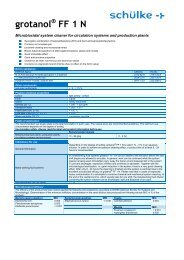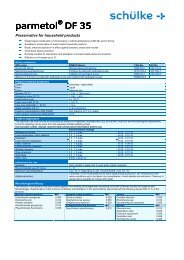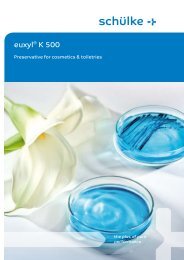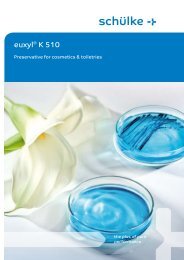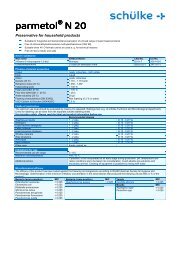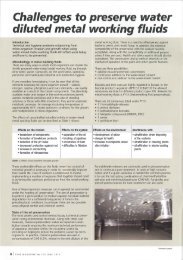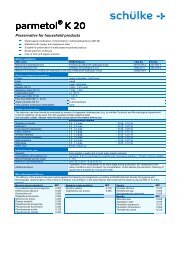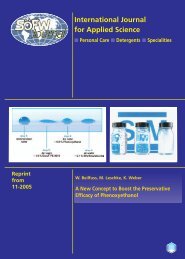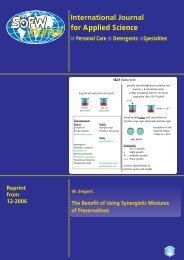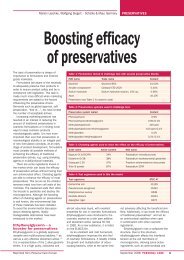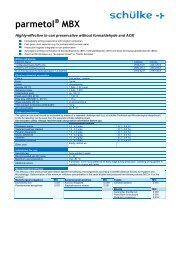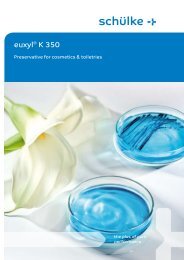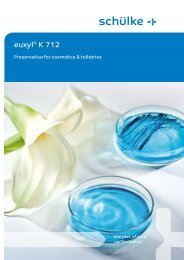International Journal for Applied Science - Schülke & Mayr
International Journal for Applied Science - Schülke & Mayr
International Journal for Applied Science - Schülke & Mayr
You also want an ePaper? Increase the reach of your titles
YUMPU automatically turns print PDFs into web optimized ePapers that Google loves.
Reprint<br />
from<br />
11-2005<br />
<strong>International</strong> <strong>Journal</strong><br />
<strong>for</strong> <strong>Applied</strong> <strong>Science</strong><br />
■ Personal Care ■ Detergents ■ Specialities<br />
W. Beilfuss, M. Leschke, K. Weber<br />
A New Concept to Boost the Preservative<br />
Efficacy of Phenoxyethanol
COSMETICS<br />
PRESERVATIVES<br />
W. Beilfuss, M. Leschke, K. Weber*<br />
A New Concept to Boost the Preservative<br />
Efficacy of Phenoxyethanol<br />
Keywords: cosmetic preservative, phenoxyethanol, ethylhexylglycerin<br />
� Introduction<br />
Abstract<br />
Anew cosmetic preservative<br />
<strong>for</strong> leave-on products based<br />
on a combination of the active<br />
ingredient phenoxyethanol<br />
and the skin care additive and deodorant<br />
active ethylhexylglycerin<br />
is presented. Ethylhexylglycerin<br />
boosts the antimicrobial activity of<br />
phenoxyethanol. Properties, antimicrobial<br />
activity and a possible<br />
mechanism of action are discussed.<br />
Most cosmetic products designed <strong>for</strong> topical<br />
application contain one or more microbicidal<br />
substances in their <strong>for</strong>mulation.<br />
The reasons <strong>for</strong> this are obvious. The<br />
raw materials used in the manufacturing<br />
of these products are rarely perfectly sterile.<br />
Finished products containing perfume,<br />
biologically active compounds or vitamins<br />
are too fragile to withstand sterilisation<br />
following conditioning. The manufacturing<br />
process is rarely aseptic. The<br />
packaging is not hermetically sealed.<br />
Above all, the use conditions following<br />
opening are such that a microbial contamination<br />
can arise, possibly being detri-<br />
mental to the health of the user or to the<br />
aesthetic appearance of the product. Thus,<br />
it is necessary to protect the product from<br />
such microbial contamination. To this end,<br />
the cosmetic market demands multipurpose<br />
cosmetic preservatives which are<br />
globally approved, cost effective and do<br />
not contain actives under any public discussion.<br />
However, the number of actives<br />
which can be used as preservatives <strong>for</strong><br />
cosmetic applications is limited. Approximately<br />
15 of the 57 preservative chemistries<br />
listed in Annex VI of the European<br />
Cosmetic Directive (76/768 EEC) are actively<br />
used. Only these few have the physical-chemical<br />
properties, as well as the efficacy<br />
and the safety assessment, which<br />
fulfil the requirements of the cosmetic<br />
industry. Furthermore, there are rarely<br />
actives on the market due to their strict<br />
control by the different legislatures of<br />
European, American and Asian countries.<br />
At present, almost every active actually<br />
used to preserve cosmetic products is the<br />
subject of public controversy. The carcinogenic<br />
potential of <strong>for</strong>maldehyde and<br />
<strong>for</strong>maldehyde-donors, as well as the sensitisation<br />
potential of organic halogen<br />
compounds is discussed. Parabens are associated<br />
with a pseudo-estrogenic and<br />
–androgenic potential, resulting in the<br />
media to linking them to breast cancer.<br />
Although in most cases scientific assessment<br />
of the suspected risks is not yet<br />
completed, the cosmetic industry has<br />
asked <strong>for</strong> alternatives to these well-known<br />
preservative actives. That is why the cosmetic<br />
market urgently needs new and innovative,<br />
multipurpose cosmetic preservatives<br />
that are able to protect cosmetic<br />
<strong>for</strong>mulations from microbial contamina-<br />
tion, without causing harm to humans. In<br />
addition, they should be globally approved,<br />
cost effective and free of any public<br />
discussion. There<strong>for</strong>e, new concepts in<br />
preservation are required.<br />
� A sophisticated combination<br />
of phenoxyethanol and<br />
ethylhexylglycerin<br />
To address the complex requirements of<br />
the cosmetic market, the new cosmetic<br />
preservative Euxyl® PE 9010 was developed<br />
primarily <strong>for</strong> the use in leave-on<br />
products. This patented liquid concentrate<br />
is <strong>for</strong>mulated from phenoxyethanol,<br />
the active ingredient, dissolving ethylhexylglycerin,<br />
a multifunctional additive.<br />
Phenoxyethanol (Fig. 1) (1,2) is a well-<br />
INCI name: Phenoxyethanol<br />
Molecular <strong>for</strong>mula: C8H10O2 CAS-name: 2-Phenoxyethanol<br />
CAS-no.: 122-99-6<br />
EINECS no.: 204-589-7<br />
EINECS name: 2-Phenoxyethanol<br />
No. according to 76/768/EEC: 29<br />
Fig. 1 Chemical structure of<br />
phenoxyethanol<br />
2 SÖFW-<strong>Journal</strong> | 131 | 11-2005
known, broadly accepted cosmetic preservative<br />
and is frequently combined with<br />
other preservative actives. It is widely<br />
used in cosmetics and toiletries in concentrations<br />
up to 1.0% <strong>for</strong> preservation,<br />
as per the European Cosmetic Directive.<br />
It is an oily liquid with a characteristic<br />
aromatic odour and a solubility in water<br />
of 2.67 g/100 ml, after sufficient stirring<br />
time.<br />
Phenoxyethanol is listed in Annex VI of<br />
the European Cosmetic Directive (76/768<br />
EEC). It is known to be a membrane active<br />
agent. A Ph. Eur. monograph on phenoxyethanol<br />
has been issued (3).<br />
Ethylhexylglycerin (Fig. 2) belongs to the<br />
class of 1-alkyl glyceryl ethers. It is a high<br />
purity, colourless and almost odourless<br />
liquid; excellent properties <strong>for</strong> use in cosmetic<br />
<strong>for</strong>mulations.<br />
1-Alkyl glyceryl ethers with a large variety<br />
of alkyl chains are well-known natural<br />
products. They are present in mammals,<br />
birds, plants, protozoa and bacteria<br />
and are particularly wide spread in<br />
marine animals.<br />
Ethylhexylglycerin was introduced to the<br />
cosmetic market as a commercial product<br />
(Sensiva® SC 50) in the year 1992 as<br />
a skin care additive and deodorant active.<br />
As a new substance it is listed on the<br />
ELINCS file.<br />
Ethylhexylglycerin is a unique, multifunctional<br />
additive <strong>for</strong> cosmetic preparations<br />
(4,5). It is accepted world-wide as a<br />
deodorant active, being a very good alternative<br />
to triclosan (6,7). Ethylhexyl-<br />
glycerin is gentle to the skin, safe and,<br />
when used as a multifunctional additive,<br />
it provides effective wetting by lowering<br />
the surface tension in aqueous systems.<br />
Euxyl® PE 9010 is a liquid preservative<br />
<strong>for</strong> cosmetics and toiletries based on<br />
phenoxyethanol. Unlike organohalogen-,<br />
isothiazolinone- or <strong>for</strong>maldehyde-based<br />
preservatives, it can be classified as a<br />
mild biocidal active (»soft preservative«).<br />
Euxyl® PE 9010 consists solely of<br />
phenoxyethanol (90%) and ethylhexylglycerin<br />
(10%). The INCI name of Euxyl®<br />
PE 9010 is phenoxyethanol (and) ethylhexylglycerin.<br />
Both components in Euxyl® PE 9010 are<br />
globally approved (Table 1).<br />
COSMETICS<br />
PRESERVATIVES<br />
INCI name: Ethylhexylglycerin<br />
Molecular <strong>for</strong>mula: C11H24O3 CAS-name: 3-[(2-Ethylhexyl)oxy]-1,2-propandiol<br />
CAS-no.: 70445-33-9<br />
ELINCS name: Sensiva® SC 50<br />
ELINCS no.: 408-080-2<br />
Fig. 2 Chemical structure of ethylhexylglycerin<br />
� Properties<br />
Phenoxyethanol Ethylhexylglycerin<br />
In Euxyl® PE 9010 the efficacy of the<br />
well-known preservative active phenoxyethanol<br />
has been enhanced. It is a clear,<br />
colourless liquid suitable <strong>for</strong> leave-on<br />
products, including the preparation of<br />
clear gels.<br />
Euxyl® PE 9010 is soluble in water up<br />
to 1.0%. In polar solvents, such as<br />
1,2-propylene glycol, propanol or acetone,<br />
it is readily soluble. In polyalcohols,<br />
such as glycerol and sorbitol, it is moderately<br />
soluble. Pure aliphatic solvents<br />
or aliphatic solvents with hydrophilic<br />
groups, such as 2-octyldecanol and isopropyl<br />
myristate, exhibit only a limited<br />
solubility.<br />
Europe / USA: INCI name: INCI name:<br />
Phenoxyethanol (active ingredient) Ethylhexylglycerin (auxiliary)<br />
Australia: listed on AICS listed on AICS/NICNAS (NA/966)<br />
Canada: listed on DSL listed on DSL<br />
Japan: phenoxyethanol is approved as a cosmetic ENCS as glycerin monoalkyl (or alkenyl, C8-C24)<br />
preservative up to 1.0% <strong>for</strong> all types of ether (No.: 2-414)<br />
cosmetics and toiletries without restrictions CLS 1999:<br />
- registered name: 2-Ethylhexyl Glycerylether<br />
- ingredient code: 532289<br />
- fully approved in all categories except eyeliner<br />
preparations, oral preparations, bath preparations<br />
(not allowed) and lip preparations (max. 1.0%)<br />
Table 1 Approval of phenoxyethanol and ethylhexylglycerin<br />
SÖFW-<strong>Journal</strong> | 131 | 11-2005 3
COSMETICS<br />
PRESERVATIVES<br />
The maximum allowed concentration<br />
according to EU Cosmetic Directive is<br />
1.1%, due to the limit of 1.0% <strong>for</strong> phenoxyethanol.<br />
At the recommended useconcentration<br />
of 0.5 to 1.0% Euxyl® PE<br />
9010 is soluble in most cosmetic <strong>for</strong>mulations.<br />
The low surface tension of<br />
Euxyl® PE 9010 solutions assures good<br />
dispersion in various systems, even at<br />
low temperature.<br />
As phenoxyethanol and ethylhexylglycerin<br />
are alcohols, the product is<br />
stable to hydrolysis, to higher temperatures<br />
(e.g. 100 °C) and to low as well as<br />
high (pH 2 - 12) pH values. Furthermore,<br />
it remains liquid with a moderate viscosity<br />
at temperatures as low as -20 °C.<br />
In general, Euxyl® PE 9010 displays good<br />
compatibility with other cosmetic ingredients.<br />
No discolourations have been detected.<br />
The product shows no interactions<br />
with sulphite ions or with pigments<br />
like TiO 2 . It can tolerate high salt content.<br />
Cationic and amphoteric substances do<br />
not adversely affect the preservative activity.<br />
However, it is yet not recommended<br />
<strong>for</strong> <strong>for</strong>mulations containing comparatively<br />
high amounts of ethoxylated surfactants<br />
because these surfactants are<br />
able to neutralise the boosting activity<br />
of ethylhexylglycerin.<br />
Due to its high solvency, Euxyl® PE 9010<br />
can serve as a solvent <strong>for</strong> lipophilic additives<br />
like perfumes, vitamins and essential<br />
oils. Formulas containing natural<br />
raw materials are particularly susceptible<br />
to microbial growth. Fast-acting<br />
Euxyl® PE 9010 can eliminate microorganisms<br />
quickly, making it more effective<br />
than slower acting preservatives.<br />
Designed as a substitute <strong>for</strong> parabencontaining<br />
preservative systems, it also<br />
offers an alternative to <strong>for</strong>maldehydereleasers<br />
and isothiazolinones. Its use is<br />
recommended in leave-on preparations,<br />
such as lotions, creams, sun care products,<br />
transparent gels and others, as well<br />
as cosmetic wet wipes.<br />
� Microbiological efficacy<br />
Euxyl® PE 9010 is equally effective against<br />
bacteria, yeasts and fungi. It is effective<br />
within a broad pH range, up to pH 12. It<br />
shows higher activity, e.g. in preservative<br />
efficacy tests (S&M KoKo test) (8,9) or in<br />
germ count reduction tests, compared<br />
Species ATCC- Euxyl® PE 9010 Phenoxy-<br />
Nr.: [%] ethanol [%]<br />
Gram-negative:<br />
Enterobacter gergoviae 33028 0.5 0.5<br />
Escherichia coli 11229 0.5 0.5<br />
Klebsiella pneumoniae 4352 0.25 0.5<br />
Pseudomonas aeruginosa 15442 0.5 0.5<br />
Pseudomonas fluorescens 17397 0.25 0.5<br />
Pseudomonas putida<br />
Gram-positive:<br />
12633 0.5 0.5<br />
Staphylococcus aureus 6538 0.5 1.0<br />
Staphylococcus epidermidis<br />
Mould fungi:<br />
12228 0.5 1.0<br />
Aspergillus niger 6275 0.25 0.5<br />
Penicillium funiculosum<br />
Yeast:<br />
36839 0.25 0.25<br />
Candida albicans 10231 0.25 0.5<br />
Table 2 MIC values (dilution test) of Euxyl® PE 9010 compared to phenoxyethanol<br />
against different microorganisms<br />
with phenoxyethanol and ethylhexylglycerin<br />
individually. The efficacy can be<br />
illustrated by the determination of<br />
the Minimum Inhibitory Concentration<br />
(MIC) values and by per<strong>for</strong>ming germ<br />
count reduction tests.<br />
MIC values<br />
To compare the MIC values of Euxyl® PE<br />
9010 with phenoxyethanol, the minimum<br />
inhibitory concentration against<br />
different microorganisms in a serial dilution<br />
test was determined (Table 2).<br />
While ethylhexylglycerin alone has no<br />
appreciable effect on microorganisms,<br />
the enhanced phenoxyethanol in Euxyl®<br />
PE 9010 is proven to have better efficacy<br />
against many microorganisms than<br />
phenoxyethanol alone.<br />
Germ count reduction test<br />
To show the effect of ethylhexylglycerin<br />
on the per<strong>for</strong>mance of phenoxyethanol<br />
as a preservative, germ count reduction<br />
tests on Pseudomonas aeruginosa (ATCC<br />
no. 15442) and Aspergillus niger (ATCC<br />
no. 6275) were per<strong>for</strong>med with dilutions<br />
of Euxyl® PE 9010 in sterile tap water<br />
and compared to the single components.<br />
Fifty-ml portions of the end solutions are<br />
each inoculated with 0.5 ml microorganism<br />
suspension and stirred. The initial<br />
microorganism count of the test solutions<br />
is approximately 10 8 cfu/ml.<br />
These solutions are streaked out onto<br />
tryptone soya agar (Pseudomonas aeruginosa)<br />
or sabouraud-dextrose 4.0% agar<br />
(Aspergillus niger) after 3, 6, 24, 48, 72<br />
and 168 hours depending on the test organism.<br />
The cultures are incubated <strong>for</strong><br />
48 hours at 37 °C or 72 hours at 25 -<br />
27 °C.<br />
The evaluation is made on the basis of<br />
semi-quantitative assessment of the microbial<br />
growth of the streaks.<br />
As Fig. 3 clearly demonstrate, ethylhexylglycerin,<br />
without having any efficacy<br />
against Pseudomonas aeruginosa or Aspergillus<br />
niger alone (green line), boosts<br />
the efficacy of phenoxyethanol as the<br />
preservative active in Euxyl® PE 9010 (blue<br />
line) compared to phenoxyethanol alone<br />
(red line). The improved efficacy of the<br />
combination can be seen after a short<br />
period of time.<br />
4 SÖFW-<strong>Journal</strong> | 131 | 11-2005
� Mode of action<br />
Ethylhexylglycerin has a chemical structure<br />
comparable to surfactants. A calculated<br />
HLB-value of 7.4 means that it belongs<br />
to the group of wetting agents or<br />
water-in-oil emulsifiers. It is able to reduce<br />
the surface tension of water significantly<br />
(Fig. 4a).<br />
In combination with phenoxyethanol in<br />
Euxyl® PE 9010 an additional reduction<br />
of the surface tension can be observed.<br />
For a 1.0% solution of Euxyl® PE 9010 in<br />
water the surface tension is 32.1 mN/m<br />
(water: 72.6 mN/m). This is even lower<br />
than the surface tension of 0.1% ethylhexylglycerin,<br />
as the contact angles of<br />
the corresponding water drops on materials<br />
like polyethylene clearly demonstrate<br />
(Fig. 4b).<br />
Although Euxyl® PE 9010 significantly reduces<br />
the interfacial tension in a foaming<br />
test according to DIN 53 902, a 1.0% solution<br />
in demineralised water proved to<br />
be non-foaming.<br />
It is postulated that the addition of ethylhexylglycerin<br />
affects the interfacial tension<br />
at the cell membrane of microorganisms.<br />
This improves the contact of<br />
phenoxyethanol with the cell membrane<br />
resulting in a better interaction of phenoxyethanol<br />
at the cell membrane and<br />
an improved antimicrobial efficacy.<br />
� Practical experience<br />
4a 4b<br />
The effectiveness of this system in cosmetic<br />
<strong>for</strong>mulations has been tested in<br />
the S&M KoKo test. This is a multiple-inoculation,<br />
preservative efficacy test designed<br />
and validated by <strong>Schülke</strong> & <strong>Mayr</strong>.<br />
A mixed suspension of Gram-positive and<br />
Gram-negative bacteria, yeast and mould<br />
COSMETICS<br />
PRESERVATIVES<br />
Fig. 3 Germ count reduction in tap water achieved by Euxyl® PE 9010 compared<br />
to the single components against Pseudomonas aeruginosa and Aspergillus niger<br />
is used <strong>for</strong> inoculation. At weekly intervals,<br />
a sample of the test product is<br />
streaked out onto nutrient media, incubated<br />
and evaluated semi-quantitatively.<br />
The longer the time be<strong>for</strong>e the occurrence<br />
of the first microbial growth, the<br />
more effective the preservative. Experience<br />
has shown that a well-preserved<br />
product should remain growth-free <strong>for</strong><br />
Fig. 4a Surface tension [mN/m] of 1.0% Euxyl® PE 9010 in water compared to 0.9% phenoxyethanol, 0.1% ethylhexylglycerin<br />
and water as well as 4b the corresponding water drops on a polyethylene surface<br />
SÖFW-<strong>Journal</strong> | 131 | 11-2005 5
COSMETICS<br />
PRESERVATIVES<br />
six inoculation cycles to ensure the shelflife<br />
required in practice (30 months in<br />
the original packaging).<br />
Oil-in-water and water-in-oil systems<br />
preserved with use-concentrations of<br />
between 0.5 and 1.0% Euxyl® PE 9010<br />
proved to be well preserved even after<br />
three months storage at +40 °C.<br />
Fig. 5 shows the result of the S&M KoKo<br />
test on a Moisturizing Soothing Balm<br />
preserved with 1.0% Euxyl® PE 9010, as<br />
well as with the single components.<br />
Only the sample preserved with 1.0%<br />
Euxyl® PE 9010 was proved to be well<br />
preserved after 6 inoculation cycles,<br />
while 0.9% phenoxyethanol as well as<br />
0.1% ethylhexylglycerin were ineffective.<br />
Whereas ethylhexylglycerin alone has no<br />
and phenoxyethanol alone shows no<br />
sufficient efficacy against microorganisms<br />
the enhanced phenoxyethanol in<br />
Euxyl® PE 9010 is proven to preserve this<br />
Moisturizing Soothing Balm very well.<br />
In rinse-off products containing high<br />
amounts ethoxylated surfactants the<br />
product is yet not recommended because<br />
these surfactants are able to neutralise<br />
the boosting activity of ethylhexylglycerin.<br />
As the interest is high in using<br />
Euxyl® PE 9010 also in rinse-off products<br />
ef<strong>for</strong>ts were made to decrease the loss of<br />
efficacy by adding complexing agents. In<br />
aqueous surfactant solutions (10% a. i.)<br />
germ count reduction tests of the combination<br />
of complexing agents with<br />
Euxyl® PE 9010 gave better results than<br />
alone. Fig. 6 shows how 0.05% EDTA<br />
and 1.0% Euxyl® PE 9010 can reduce<br />
Fig. 7 Carbomer gels, gel 1: unpreserved; gel<br />
2: preserved with 1.0% Euxyl® PE 9010; gel 3:<br />
preserved with 1.0% of a standard paraben<br />
mixture in phenoxyethanol<br />
Fig. 5 Result of preservative efficacy test on the Moisturizing Soothing Balm<br />
during 6 inoculation cycles<br />
Fig. 6 Germ count reduction test in ethoxylated surfactant solutions against<br />
Pseudomonas aeruginosa in the presence of complexing agents<br />
Pseudomonas aeruginosa also in frequently<br />
used ethoxylated surfactant solutions.<br />
These results may encourage <strong>for</strong>mulators<br />
to check if the combination of Euxyl® PE<br />
9010 with complexing agents can successfully<br />
preserve surfactant based rinseoff<br />
products. At this early stage of experience<br />
it is strongly recommended to check<br />
the individual finished product as the efficacy<br />
might depend on the particular<br />
<strong>for</strong>mulation.<br />
Furthermore Euxyl® PE 9010 is ideal <strong>for</strong><br />
the preservation of clear, transparent gels.<br />
As Fig. 7 shows, gels preserved with the<br />
product (gel 2) stay clear and transparent<br />
compared to a standard paraben<br />
mixture in phenoxyethanol (gel 3).<br />
� Conclusion<br />
Euxyl® PE 9010 is an answer to the personal<br />
care industry’s increasing demands<br />
<strong>for</strong> new preservation concepts. It is an<br />
broad-spectrum preservative based on<br />
phenoxyethanol in combination with the<br />
multifunctional ethylhexylglycerin. The<br />
6 SÖFW-<strong>Journal</strong> | 131 | 11-2005
addition of ethylhexylglycerin affects the<br />
interfacial tension at the cell membrane<br />
of microorganisms, improving the preservation<br />
activity of phenoxyethanol impressively.<br />
It is is a patented liquid concentrate<br />
with extensive toxicological data<br />
on its ingredients. Its physical and<br />
chemical properties, as well as its microbiological<br />
efficacy, make Euxyl® PE 9010<br />
ideal <strong>for</strong> the <strong>for</strong>mulation of skin care<br />
products. It is focused <strong>for</strong> leave-on products<br />
and ideal <strong>for</strong> the preservation of<br />
clear, transparent gels. This new preservative<br />
system is a reasonable alternative<br />
to classical preservation blends.<br />
Literature<br />
(1) The Merck Index, Thirteenth Ed., Monograph Nr.<br />
7341<br />
(2) H. P. Fiedler, Lexikon der Hilfsstoffe für Pharmazie,<br />
Kosmetik und angrenzenden Gebiete,<br />
Editio Verlag Aulendorf, 5. Aufl., 2002, 1305 –<br />
1306<br />
(3) Hagers Handbuch der pharmazeutischen Praxis,<br />
Springer-Verlag Berlin, 5. Auflage, Folgeband 5,<br />
1999, 425 – 426<br />
(4) H. Eggensperger, Multiaktive Wirkstoffe für<br />
Kosmetika, Verlag für chemische Industrie H.<br />
Ziolkowsky GmbH Augsburg, 1995, 141 – 159<br />
(5) W. Beilfuß, W. Siegert, Cossma, 2003, 6, 54 – 55<br />
(6) W. Beilfuß, SÖFW <strong>Journal</strong>, 1998, 6, 360 – 366<br />
(German edition)<br />
(7) H. M. Fishman, Happi, 2005, Vol. 42, No. 2, part<br />
1 of 2, 35<br />
(8) K. Weber, J. Siebert, SÖFW-<strong>Journal</strong>, 2003, 6, 44 –<br />
50 (English); 48 – 55 (German edition)<br />
(9) W. Siegert, Cosmetic <strong>Science</strong> Technology, 2005,<br />
189 – 195.<br />
* Authors’ address:<br />
Dr. Wolfgang Beilfuss<br />
Dr. Marion Leschke<br />
Dr. Klaus Weber<br />
<strong>Schülke</strong> & <strong>Mayr</strong> GmbH<br />
22840 Norderstedt<br />
Germany<br />
Email: sai@schuelke-mayr.com<br />
�<br />
COSMETICS<br />
PRESERVATIVES<br />
SÖFW-<strong>Journal</strong> | 131 | 11-2005 7




